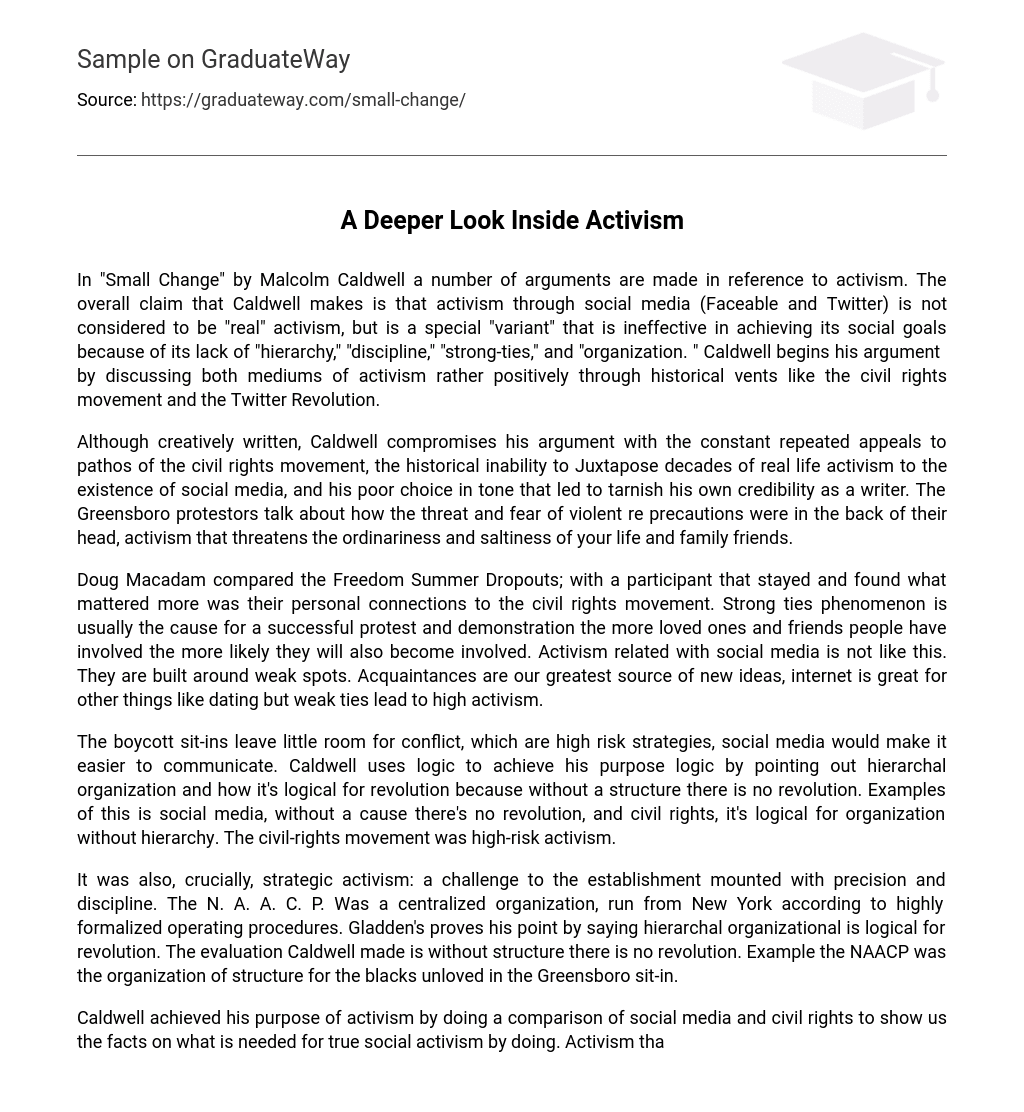In “Small Change” by Malcolm Caldwell a number of arguments are made in reference to activism. The overall claim that Caldwell makes is that activism through social media (Faceable and Twitter) is not considered to be “real” activism, but is a special “variant” that is ineffective in achieving its social goals because of its lack of “hierarchy,” “discipline,” “strong-ties,” and “organization. ” Caldwell begins his argument by discussing both mediums of activism rather positively through historical vents like the civil rights movement and the Twitter Revolution.
Although creatively written, Caldwell compromises his argument with the constant repeated appeals to pathos of the civil rights movement, the historical inability to Juxtapose decades of real life activism to the existence of social media, and his poor choice in tone that led to tarnish his own credibility as a writer. The Greensboro protestors talk about how the threat and fear of violent re precautions were in the back of their head, activism that threatens the ordinariness and saltiness of your life and family friends.
Doug Macadam compared the Freedom Summer Dropouts; with a participant that stayed and found what mattered more was their personal connections to the civil rights movement. Strong ties phenomenon is usually the cause for a successful protest and demonstration the more loved ones and friends people have involved the more likely they will also become involved. Activism related with social media is not like this. They are built around weak spots. Acquaintances are our greatest source of new ideas, internet is great for other things like dating but weak ties lead to high activism.
The boycott sit-ins leave little room for conflict, which are high risk strategies, social media would make it easier to communicate. Caldwell uses logic to achieve his purpose logic by pointing out hierarchal organization and how it’s logical for revolution because without a structure there is no revolution. Examples of this is social media, without a cause there’s no revolution, and civil rights, it’s logical for organization without hierarchy. The civil-rights movement was high-risk activism.
It was also, crucially, strategic activism: a challenge to the establishment mounted with precision and discipline. The N. A. A. C. P. Was a centralized organization, run from New York according to highly formalized operating procedures. Gladden’s proves his point by saying hierarchal organizational is logical for revolution. The evaluation Caldwell made is without structure there is no revolution. Example the NAACP was the organization of structure for the blacks unloved in the Greensboro sit-in.
Caldwell achieved his purpose of activism by doing a comparison of social media and civil rights to show us the facts on what is needed for true social activism by doing. Activism that Caldwell leans towards the civil rights pavement. Americans know about this time of history, it’s a natural emotional topic. Speaking objectively this could be used positively in Gladden’s argument, but the underlying problem that weakens Gladden’s argument is that he chooses to keep bringing up the civil rights movement in every circumstance that involves arguing activism in real life.
This either says that Caldwell knows little of activism or that there isn’t a whole lot of what Caldwell calls “high-risk” activism that is strong enough to differentiate itself from activism in social media. The civil rights movement allows operation, it segregates real life activism from activism in social media but ultimately one strong era of history isn’t nearly enough to make a very strong claim that real activism is that much of a separation between activism in social media.
Gladden’s appeal towards the audience’s emotion in regards to real life activism is one-dimensional. In Gladden’s mind his appeal to emotion involves throwing the civil rights movement in the audiences face every single time. Caldwell uses historical information on effects on society, and people who take on a modern day approach on effects on society through social media. Glacial uses the example saying people in modern era think social activism is only possible with newer technology, but they forget this has been happening since the existence of civilization.
New insights I learned after reading Gladden’s article is my view on activism. Which is the use of campaigning to bring about social change. Caldwell says Faceable and twitter is making it easier for the powerless to give their voice this is an example of social activism. Activism that threatens the ordinariness of your life and family and friends, its not for people whose hearts are not truly involved in the cause.





